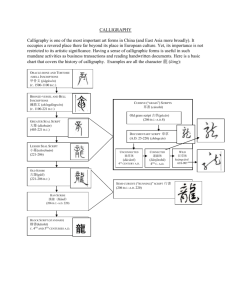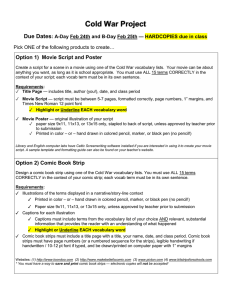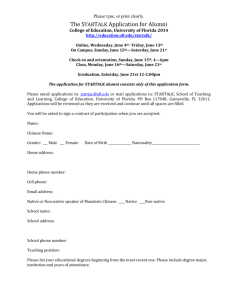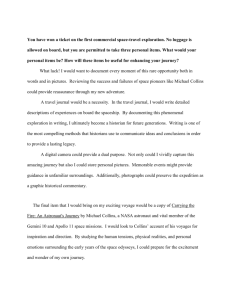學生能聽和說
advertisement
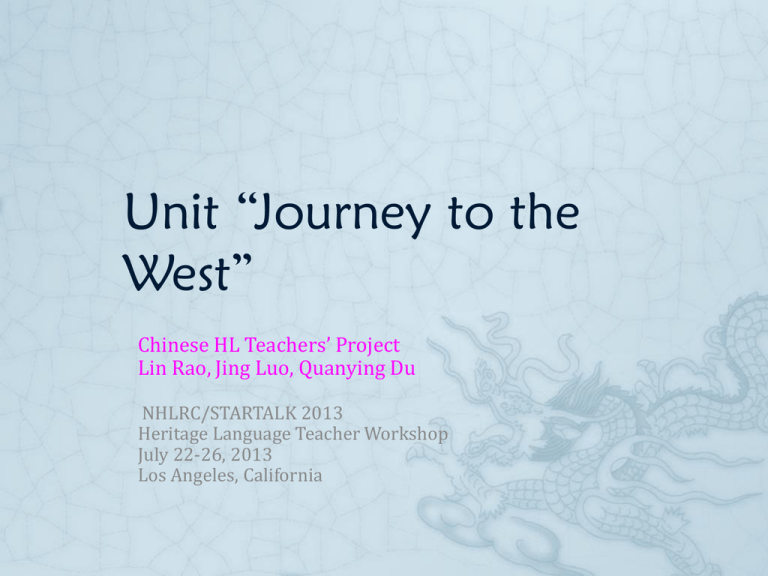
Unit “Journey to the West” Chinese HL Teachers’ Project Lin Rao, Jing Luo, Quanying Du NHLRC/STARTALK 2013 Heritage Language Teacher Workshop July 22-26, 2013 Los Angeles, California Differentiated Instructional Strategies Addressing Students’ Learning Styles (use of multimedia, pictures, text, characters & Pinyin to present material) Scaffolding to connect to students’ prior knowledge and skills Work in heterogeneous groups (encompass various proficiency levels and cultural backgrounds) Learning Centers (word wall, multimedia center) Assignments (script writing and performing) Goals目標: Unit Goals 學生能夠以簡單的句子說出唐三藏和他的弟子 學生能說出並且利用基本动作词和成语 學生能說出西遊記的故事,並且能夠畫出故事圖來表現出故事發生的過程。 Content Objectives 教學内容/目標: 學生能表演出故事的一段內容/主角的特色 學生能簡單說出故事内容 學生能創造出自己的版本 學生能說出並且利用基本情緒詞彙 Language Objectives語言目標: 學生能聽和說:名字:孫悟空、豬八戒、沙和尚、唐三藏、詞彙以及用动作詞彙創作簡單句子 Cultural Connection 文化貫連:.中國式教室禮貌、中國四大名著之一-西遊記。 成语故事 Unit Sequence Day 1: Introduction of the Text Day 2: Practice using the vocabulary Day 3: Character analysis Day 4: Script writing Day 5: Rehearsal Day 6: Play night Day 1: Introduction of the Text •Students watch a short video clip and discuss the story “Journey to the West”. •Teacher summarizes and introduces author and background. •Students work in groups and read a section of the story and discuss what they know and don’t know about the text. •Each group act out their section and key vocabulary. •Whole class reorganize different sections to form the whole story. 8 Folk novel http://en.wikipedia.org/wiki/Journey_to_the_West Day 2: Practice using the vocabulary Matching of Chinese and English/picture (students will receive a set of key vocabulary flashcards with Chinese, English, or pictures based on their proficiency levels) 成语 Sentence building (students will receive sentence starters from the teacher and complete sentences using the key vocabulary) Comic drawing (students will receive blank comic strips and complete using key vocabulary) 10 花容月貌:像花朵般娇艳美好的容颜;月貌:似明月般荧 光月华的相貌。如花似月的容貌。形容女子美貌。 火眼金睛:原指《西游记》中孙 悟空能识别妖魔鬼怪的眼睛。后 用以形容人的眼光锐利,能够识 别真伪。 Day 3: Character analysis Students work in groups and discuss the following questions and then report to the whole class. What are the conflicts in the story? What caused the conflicts? How the 3 apprentices reacted to the conflict? What would you do in this situation and why? Start to brainstorm their version of the story. 12 Day 4: Script writing Teacher explain and share the rubrics for the final project Possible forms of presentation: puppet show, dramatization Length of performance Number of characters, narrators Key vocabulary bank Group collaboration Time frame 14 Day 5: Rehearsal 15 Day 6: Play night Class and family 16 Assessments Combination of Formative and Summative assessment: Pre-unit Assessment (knowledge of content, vocabulary) - KWL chart and brainstorming (classroom) Ongoing Assessment (exit cards, informal observation) Holistic Rubric (Project evaluation, peer assessment) Holistic Assessment: Project Evaluation Presentation: Chronology of the story (beginning, middle, end) Use of voice expressions and actions (intonation, stress, tones) Fluency and Accuracy (use of verb) Use of 4 character idioms (1-2) Key vocabulary(at least10 from the vocabulary bank)


